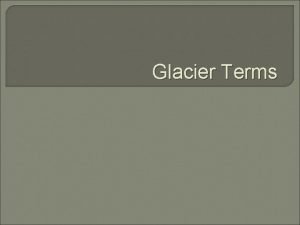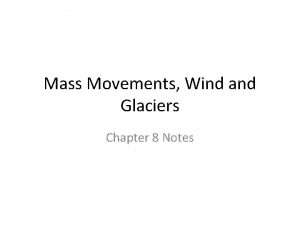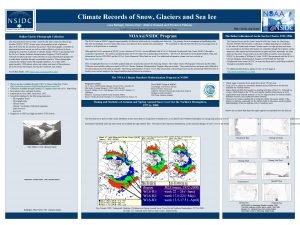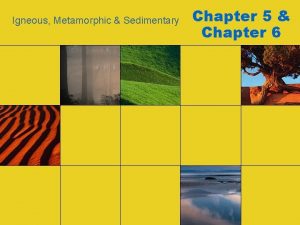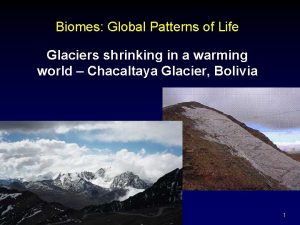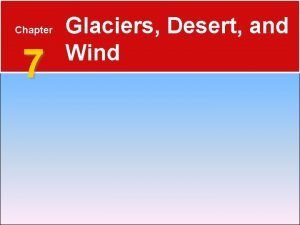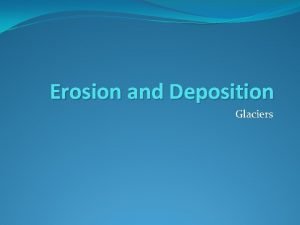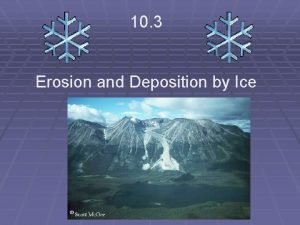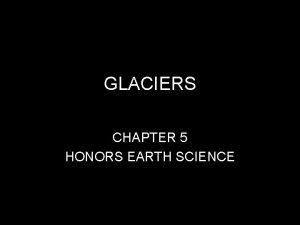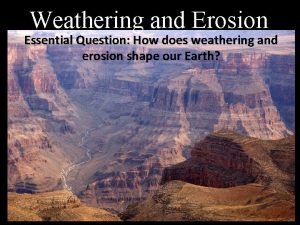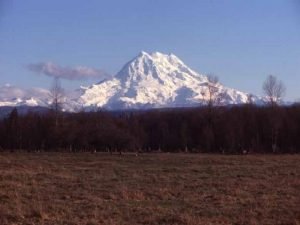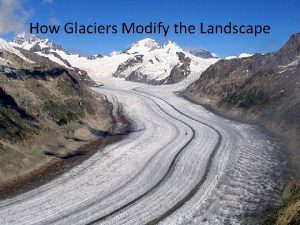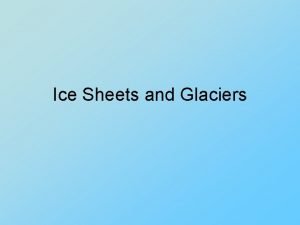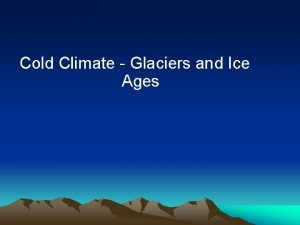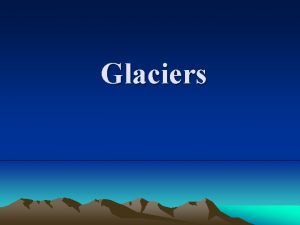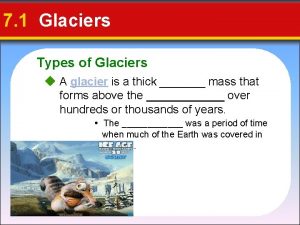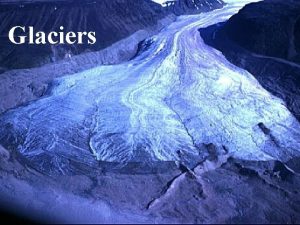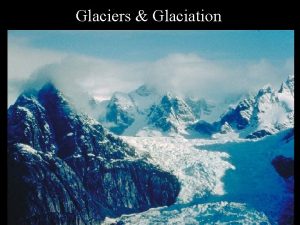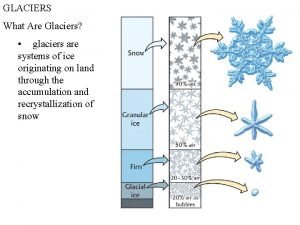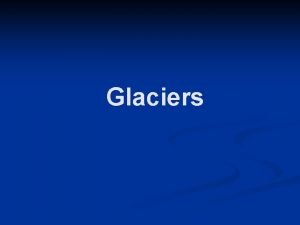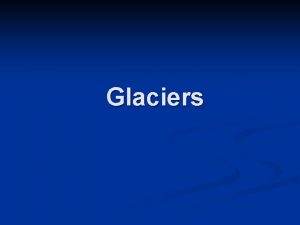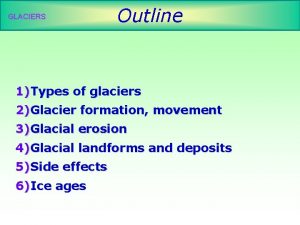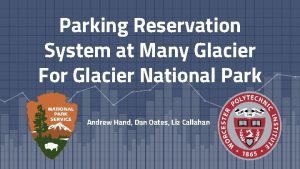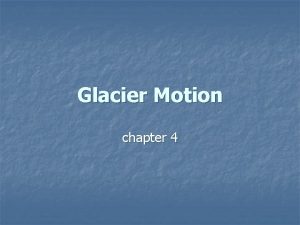Glacier Formation Glaciers are formed from layer after

















- Slides: 17

Glacier Formation • Glaciers are formed from layer after layer of compacted snow. • As the snow compacts, it loses trapped air, becoming harder and more dense. • The individual flakes connect to form very large ice crystals (up to a 100 m in size). This is glacial ice (which appears a blue tint. )

Which sample is from near the top of an ice core? The middle? The bottom?

• The area on a glacier where material is added on is called the accumulation zone. – This area is usually near the top of the glacier. • The process of removing material from a glacier is called ablation (and occurs in the ablation zone). – This occurs not only from melting (at the surface or base), but also from evaporation (at the surface) and calving. • Calving is the process of forming an iceberg. • The place where the accumualation zone and ablation zones meet is called the equilibrium line.

Glacier Movement • Even though glaciers are very large, they can still move (albeit very slowly). • Where do they get the energy? • GRAVITY! They always move downhill. If the force of gravity is sufficient to overcome frictional forces, then movement will occur. • This can happen in a number of ways. . .

Internal Deformation • The glacier is “flattened”, but does not actually move. • The leading edge, (a. k. a. glacier terminus, or nose) moves out away from the centre.

Basal Sliding and Deforming Substrate • In order for a glacier to truly slide, friction must be reduced. • In basal sliding this is done through a layer of water that results at the base due to the very high pressure. Water lubricates the contact points, easing movement. • Also, if the sediment under the glacier is loose it may carry the entire glacier with it when it slides.

Is the South Pole Moving? • Antarctica is a large glacier. Thus, it is capapble of moving over top of the land it’s built on. • As a result, pegs inserted into the ice at the geographic south pole will actually move considerably each year!

Types and Sizes of Ice • Continental Glaciers: ice sheets and ice caps – completely cover the surrounding topography – ice sheets are larger than ice caps – Eg. Antarctica, Greenland, “Ice Age”

Types and Sizes of Ice • Ice Shelves – a floating ice mass that is attached to the coast along at least one edge

Types and Sizes of Ice • Valley glaciers – these are the fast moving glaciers that fill the contours of a valley – usually steep and carry vast quantities of rock sediment

Types and Sizes of Ice • Icebergs – chunks of glacier that break off and float away.

Glacial Erosion • Glaciers are very good at eroding rock and soil. They are 3 mechanisms in which this occurs: – 1) The sheer weight of the ice allows it to penetrate deep into soil or rock. It then plows material in the direction it is moving. The is called scouring. – 2) At the base of the glacier ice can melt and refreeze. When it refreezes it can trap loose rock and sediment that becomes part of the glacier and moves with it. – 3) Melting water can enter cracks in rocks. If it freezes it can attach firmly to parts of the rock around the cracks. When the glacier moves, the ice in the cracks can rip the surrounding rock away. This is called plucking.

Glacial Erosion (cont. ) • When the glacier recedes it often leaves striations. These are distinctive “scratches” in the bedrock caused by harder trapped rocks in the base of the glacier rubbing against the underlying rock. • These markings are handy for scientists because it allows them to determine the direction that the glacier was moving. • Unsorted material carried by the glacier and deposited when it melts is called till.

Glacial Landforms • 1) Many common land features are a result of glacial movement. Moraines are mounds of till deposited when glaciers recede (melt). The most interesting is a terminal moraine, which is formed from till at the leading edge of the glacier.

Glacial Landforms 2) Drumlins is thought to have formed when a new glacier moves over an old moraine. As a result they are much smaller than moraines and point parallel to the direction of glacier movement. One side is usually steeper than the other. This is the side from which the glacier came.

Glacial Landforms 3) Melted ice can flow through long ridges (like tunnels) under the glacier. Till is often carried in these streams and becomes deposited in certain points, building up to become higher than the surrounding rock. When the glacier melts, the mound that is left over will run roughly parallel to the glacial movement. This is called an esker.

• There are many more formations that are related to glaciers, including many types of lakes and streams. Read about them (and review glacier concepts) in the following HW: – Read section 15. 1, do #1, 3, 4, 5 p. 320 – Read section 15. 2, do #1, 3, 4, 5 p. 325 – Read section 15. 3, do #5, 6
 Glacier terms
Glacier terms Insidan region jh
Insidan region jh After me after me after me
After me after me after me If any man will come after me
If any man will come after me Examples of mass movement
Examples of mass movement Nsidc glaciers
Nsidc glaciers Continental divide minnesota
Continental divide minnesota Angular sedimentary rocks
Angular sedimentary rocks Bolivia glaciers
Bolivia glaciers Chapter 7 glaciers deserts and wind
Chapter 7 glaciers deserts and wind Is a valley
Is a valley Glacial drift vs till
Glacial drift vs till Moraine
Moraine Glaciers cause erosion by abrasion and
Glaciers cause erosion by abrasion and Secure socket layer and transport layer security
Secure socket layer and transport layer security Layer 6 presentation layer
Layer 6 presentation layer Layer 2 e layer 3
Layer 2 e layer 3 Secure socket layer and transport layer security
Secure socket layer and transport layer security
